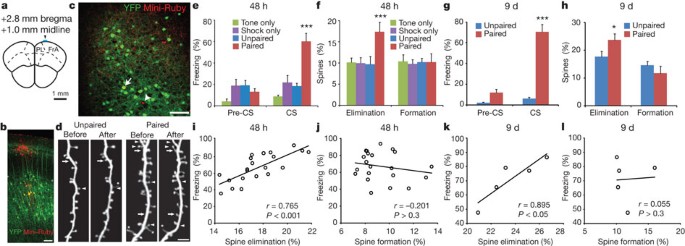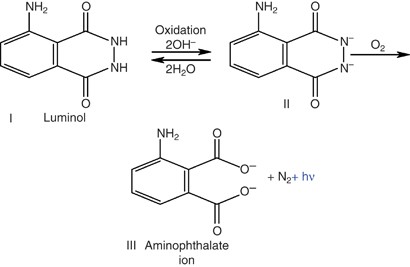
- Select a language for the TTS:
- UK English Female
- UK English Male
- US English Female
- US English Male
- Australian Female
- Australian Male
- Language selected: (auto detect) - EN
Play all audios:
ABSTRACT It is generally believed that fear extinction is a form of new learning that inhibits rather than erases previously acquired fear memories1,2,3. Although this view has gained much
support from behavioural and electrophysiological studies1,2,3,4,5,6,7,8,9,10, the hypothesis that extinction causes the partial erasure of fear memories remains viable. Using transcranial
two-photon microscopy11,12, we investigated how neural circuits are modified by fear learning and extinction by examining the formation and elimination of postsynaptic dendritic spines of
layer-V pyramidal neurons in the mouse frontal association cortex. Here we show that fear conditioning by pairing an auditory cue with a footshock increases the rate of spine elimination. By
contrast, fear extinction by repeated presentation of the same auditory cue without a footshock increases the rate of spine formation. The degrees of spine remodelling induced by fear
conditioning and extinction strongly correlate with the expression and extinction of conditioned fear responses, respectively. Notably, spine elimination and formation induced by fear
conditioning and extinction occur on the same dendritic branches in a cue- and location-specific manner: cue-specific extinction causes formation of dendritic spines within a distance of two
micrometres from spines that were eliminated after fear conditioning. Furthermore, reconditioning preferentially induces elimination of dendritic spines that were formed after extinction.
Thus, within vastly complex neuronal networks, fear conditioning, extinction and reconditioning lead to opposing changes at the level of individual synapses. These findings also suggest that
fear memory traces are partially erased after extinction. Access through your institution Buy or subscribe This is a preview of subscription content, access via your institution ACCESS
OPTIONS Access through your institution Subscribe to this journal Receive 51 print issues and online access $199.00 per year only $3.90 per issue Learn more Buy this article * Purchase on
SpringerLink * Instant access to full article PDF Buy now Prices may be subject to local taxes which are calculated during checkout ADDITIONAL ACCESS OPTIONS: * Log in * Learn about
institutional subscriptions * Read our FAQs * Contact customer support SIMILAR CONTENT BEING VIEWED BY OTHERS GENERALIZED EXTINCTION OF FEAR MEMORY DEPENDS ON CO-ALLOCATION OF SYNAPTIC
PLASTICITY IN DENDRITES Article Open access 31 January 2023 HIPPOCAMPUS AND AMYGDALA FEAR MEMORY ENGRAMS RE-EMERGE AFTER CONTEXTUAL FEAR RELAPSE Article 08 August 2022 RAC1 GTPASE ACTIVATION
IMPAIRS FEAR CONDITIONING-INDUCED STRUCTURAL CHANGES IN BASOLATERAL AMYGDALA NEURONS AND LONG-TERM FEAR MEMORY FORMATION Article 15 December 2022 REFERENCES * Myers, K. M. & Davis, M.
Mechanisms of fear extinction. _Mol. Psychiatry_ 12, 120–150 (2007) Article CAS Google Scholar * Quirk, G. J. & Mueller, D. Neural mechanisms of extinction learning and retrieval.
_Neuropsychopharmacology_ 33, 56–72 (2008) Article Google Scholar * Bouton, M. E. Context and behavioral processes in extinction. _Learn. Mem._ 11, 485–494 (2004) Article Google Scholar
* Rescorla, R. A. & Heth, C. D. Reinstatement of fear to an extinguished conditioned stimulus. _J. Exp. Psychol. Anim. Behav. Process._ 1, 88–96 (1975) Article CAS Google Scholar *
Bouton, M. E. & King, D. A. Contextual control of the extinction of conditioned fear: tests for the associative value of the context. _J. Exp. Psychol. Anim. Behav. Process._ 9, 248–265
(1983) Article CAS Google Scholar * Thomas, D. R. & Sherman, L. An assessment of the role of handling cues in “spontaneous recovery” after extinction. _J. Exp. Anal. Behav._ 46,
305–314 (1986) Article CAS Google Scholar * Herry, C. et al. Switching on and off fear by distinct neuronal circuits. _Nature_ 454, 600–606 (2008) Article ADS CAS Google Scholar *
Burgos-Robles, A., Vidal-Gonzalez, I. & Quirk, G. J. Sustained conditioned responses in prelimbic prefrontal neurons are correlated with fear expression and extinction failure. _J.
Neurosci._ 29, 8474–8482 (2009) Article CAS Google Scholar * Milad, M. R. & Quirk, G. J. Neurons in medial prefrontal cortex signal memory for fear extinction. _Nature_ 420, 70–74
(2002) Article ADS CAS Google Scholar * Tronson, N. C. et al. Segregated populations of hippocampal principal CA1 neurons mediating conditioning and extinction of contextual fear. _J.
Neurosci._ 29, 3387–3394 (2009) Article CAS Google Scholar * Grutzendler, J., Kasthuri, N. & Gan, W. B. Long-term dendritic spine stability in the adult cortex. _Nature_ 420, 812–816
(2002) Article ADS CAS Google Scholar * Yang, G., Pan, F. & Gan, W. B. Stably maintained dendritic spines are associated with lifelong memories. _Nature_ 462, 920–924 (2009) Article
ADS CAS Google Scholar * LeDoux, J. E. Emotion circuits in the brain. _Annu. Rev. Neurosci._ 23, 155–184 (2000) Article CAS Google Scholar * Kim, J. H. & Richardson, R. The
effect of temporary amygdala inactivation on extinction and reextinction of fear in the developing rat: unlearning as a potential mechanism for extinction early in development. _J.
Neurosci._ 28, 1282–1290 (2008) Article CAS Google Scholar * Hong, I., Song, B., Lee, S., Kim, J. & Choi, S. Extinction of cued fear memory involves a distinct form of depotentiation
at cortical input synapses onto the lateral amygdala. _Eur. J. Neurosci._ 30, 2089–2099 (2009) Article Google Scholar * Lin, C. H., Yeh, S. H., Lu, H. Y. & Gean, P. W. The similarities
and diversities of signal pathways leading to consolidation of conditioning and consolidation of extinction of fear memory. _J. Neurosci._ 23, 8310–8317 (2003) Article CAS Google Scholar
* Merlo, E. & Romano, A. Memory extinction entails the inhibition of the transcription factor NF-κB. _PLoS ONE_ 3, e3687 (2008) Article ADS Google Scholar * Clem, R. L. &
Huganir, R. L. Calcium-permeable AMPA receptor dynamics mediate fear memory erasure. _Science_ 330, 1108–1112 (2010) Article ADS CAS Google Scholar * Denk, W., Strickler, J. H. &
Webb, W. W. Two-photon laser scanning fluorescence microscopy. _Science_ 248, 73–76 (1990) Article ADS CAS Google Scholar * Condé, F., Maire-Lepoivre, E., Audinat, E. & Crepel, F.
Afferent connections of the medial frontal cortex of the rat. II. Cortical and subcortical afferents. _J. Comp. Neurol._ 352, 567–593 (1995) Article Google Scholar * McDonald, A. J.
Organization of amygdaloid projections to the mediodorsal thalamus and prefrontal cortex: a fluorescence retrograde transport study in the rat. _J. Comp. Neurol._ 262, 46–58 (1987) Article
CAS Google Scholar * Sacchetti, B., Baldi, E., Lorenzini, C. A. & Bucherelli, C. Role of the neocortex in consolidation of fear conditioning memories in rats. _Exp. Brain Res._ 152,
323–328 (2003) Article Google Scholar * Garcia, R., Vouimba, R. M., Baudry, M. & Thompson, R. F. The amygdala modulates prefrontal cortex activity relative to conditioned fear.
_Nature_ 402, 294–296 (1999) Article ADS CAS Google Scholar * Ziv, N. E. & Smith, S. J. Evidence for a role of dendritic filopodia in synaptogenesis and spine formation. _Neuron_ 17,
91–102 (1996) Article CAS Google Scholar Download references ACKNOWLEDGEMENTS We thank J. LeDoux as well as all the members in the Gan laboratory for comments on the manuscript. This
work was supported by National Institutes of Health grant NS047325 and the Investigator-Initiated Research Grant from the Alzheimer‘s Association (W.-B.G.), and by the National Science
Foundation (#IOS-0757780), a 2008 NARSAD Independent Investigator Award and the G. Harold & Leila Y. Mathers Foundation (T.F.F.). AUTHOR INFORMATION AUTHORS AND AFFILIATIONS * Department
of Physiology and Neuroscience, Molecular Neurobiology Program, Skirball Institute, New York University School of Medicine, 540 First Avenue, New York, New York 10016, USA, Cora Sau Wan Lai
& Wen-Biao Gan * Departments of Psychiatry and Pharmacology, New York University School of Medicine, 550 First Avenue, New York, New York 10016, USA, Thomas F. Franke Authors * Cora Sau
Wan Lai View author publications You can also search for this author inPubMed Google Scholar * Thomas F. Franke View author publications You can also search for this author inPubMed Google
Scholar * Wen-Biao Gan View author publications You can also search for this author inPubMed Google Scholar CONTRIBUTIONS C.S.W.L. and W.-B.G. designed the imaging experiments. C.S.W.L.,
W.-B.G. and T.F.F. designed the behavioural paradigms. C.S.W.L. performed all the experiments and data analysis. T.F.F. helped with the behavioural data analysis. W.-B.G. supervised the
work. W.-B.G., C.S.W.L. and T.F.F. wrote the manuscript. CORRESPONDING AUTHOR Correspondence to Wen-Biao Gan. ETHICS DECLARATIONS COMPETING INTERESTS The authors declare no competing
financial interests. SUPPLEMENTARY INFORMATION SUPPLEMENTARY INFORMATION This file contains Supplementary Figures 1-7 with legends, Supplementary Text 1-2 and an additional reference. (PDF
3044 kb) POWERPOINT SLIDES POWERPOINT SLIDE FOR FIG. 1 POWERPOINT SLIDE FOR FIG. 2 POWERPOINT SLIDE FOR FIG. 3 POWERPOINT SLIDE FOR FIG. 4 POWERPOINT SLIDE FOR FIG. 5 RIGHTS AND PERMISSIONS
Reprints and permissions ABOUT THIS ARTICLE CITE THIS ARTICLE Lai, C., Franke, T. & Gan, WB. Opposite effects of fear conditioning and extinction on dendritic spine remodelling. _Nature_
483, 87–91 (2012). https://doi.org/10.1038/nature10792 Download citation * Received: 13 July 2011 * Accepted: 09 December 2011 * Published: 19 February 2012 * Issue Date: 01 March 2012 *
DOI: https://doi.org/10.1038/nature10792 SHARE THIS ARTICLE Anyone you share the following link with will be able to read this content: Get shareable link Sorry, a shareable link is not
currently available for this article. Copy to clipboard Provided by the Springer Nature SharedIt content-sharing initiative








